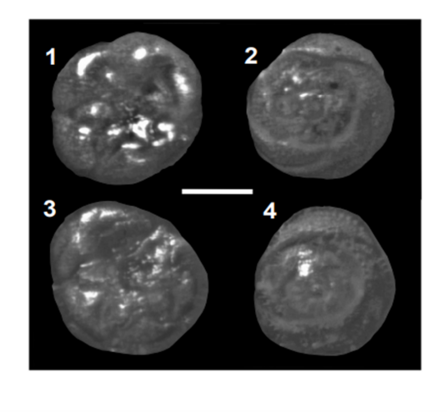Volunteers at The Wildlife Trust of South & West Wales' Cardigan Bay Marine Wildlife Centre (CBMWC) are united in their interest in dolphins, but also have a range of other marine interests (birds, fishes, seals, rock pool communities).
Volunteer Professor Emeritus Brent Wilson can usually be found checking the Centre’s data entry. He has, however, an interest in minute life forms. Since his retirement and relocation to New Quay, he has worked especially on foraminifera (forams for short, but also affectionately called ‘bugs’).
These are single celled, testate (shelled) creatures typically smaller than 1 mm across that can be found in nearshore areas living on either the seafloor or on plant substrates (seaweeds, calcareous algae, seagrasses). Brent has locally published papers on the relationship between forams and honeycomb worms (Wilson and Hayek, 2019) and the calcareous red alga Corallina (Wilson and Hayek, 2020), and has found the tests of several species of foram in the Irish Sea that have been transported here from the Caribbean Sea (Wilson and Kaminski, 2023), presumably by the Gulf Stream. All these studies benefited greatly from discussions with staff members of the CBMWC.
In a study of forams in nearby Liverpool Bay (Bae Lerpwl) published this July, Brent found a species of foram that, though it had previously been illustrated from Cardigan Bay by Haynes (1973) as Asterigerinata mamilla Williamson, is in fact new to science (see Wilson and Hayek, 2023).
As shown in Figures 1 and 2, Asterigerinata murraynhaynesi Wilson and Hayek differs from the much more common A. mamilla (see Figs. 3 and 4) in having a rounded, not keeled, periphery, and in lacking the row of white pores that would throughout the test have marked the inner edge of a marginal keel. The white scale bar is 100 microns long.
Brent was delighted, in finding this new species, to be able to honour the late Professors John Murray and Jo Haynes, both of whom had worked widely on forams around the British Isles.
Brent’s work shows that there are still novel aspects of Cardigan Bay marine wildlife to be discovered. He hopes his finding will encourage other volunteers to report any unusual findings, sightings or animal behaviours in the New Quay area to the Wildlife Trusts CBMWC marine team.

